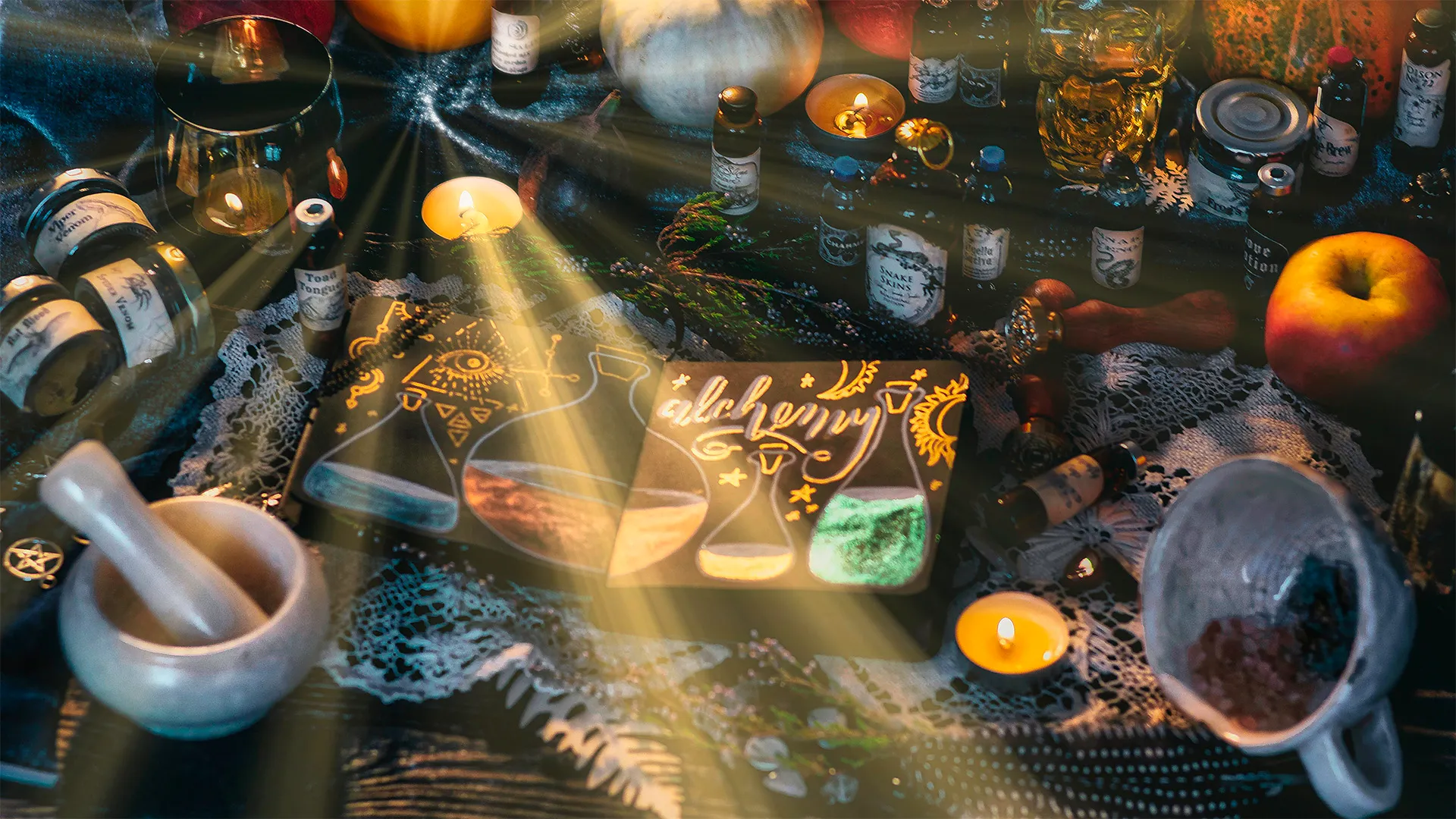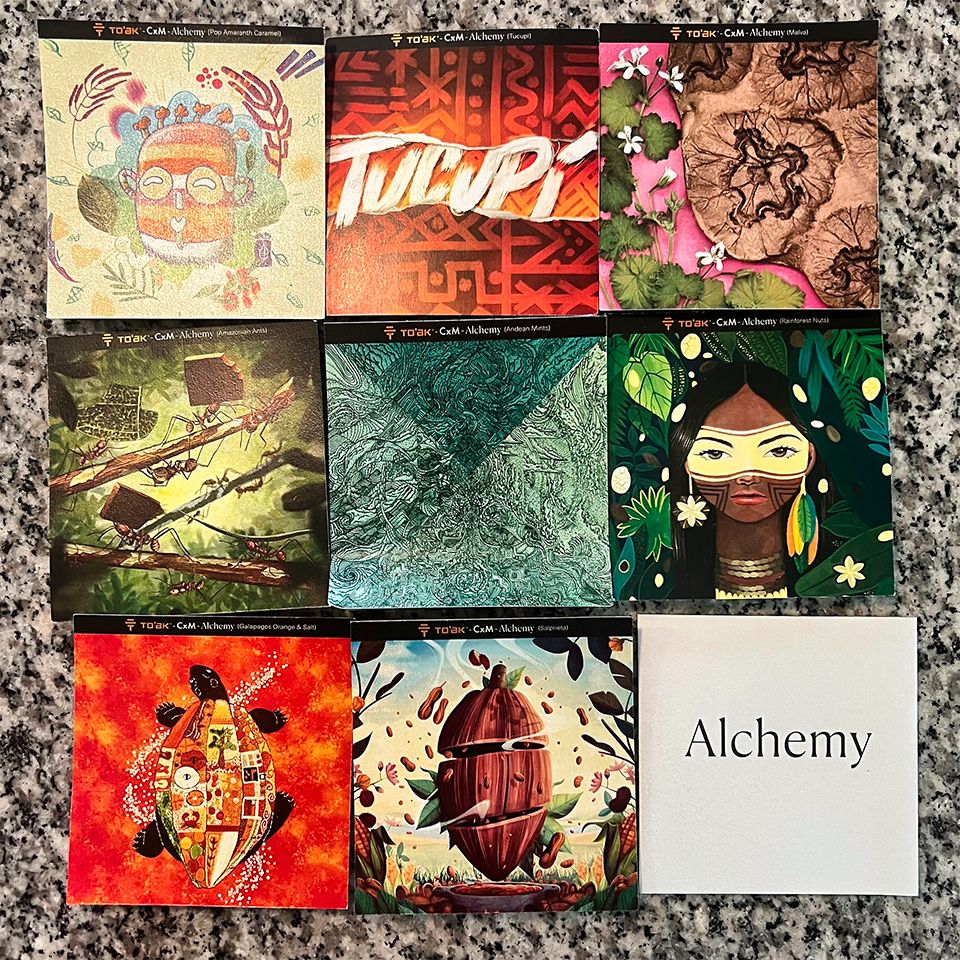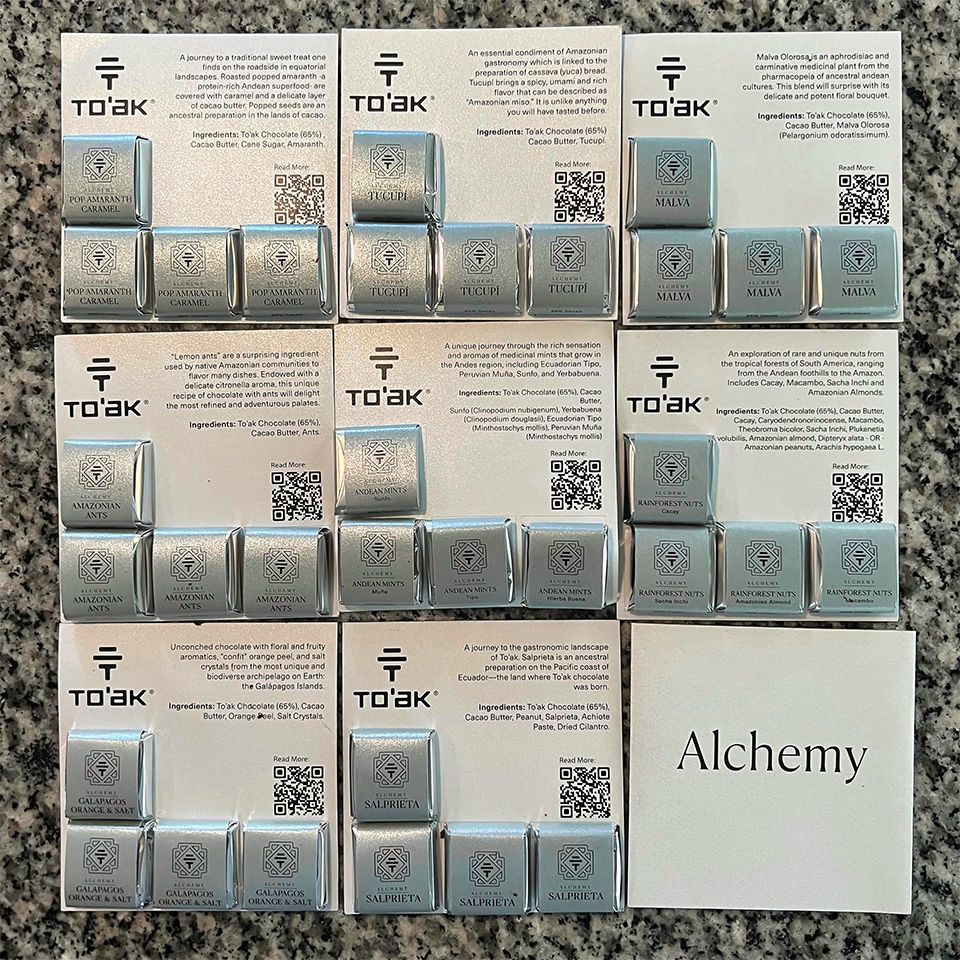Review: The To'ak CXM Alchemy Collection

Infamous for being the most expensive chocolates in the world – how are attempts to make the chocolates more accessible, and less expensive?
To’ak Chocolate – The World’s Finest Dark Chocolate from Ecuador.

Click to visit the To'ak website.
But, which is it? Is To’ak “The World’s Finest Dark Chocolate (irrespective of country of manufacture)?” Or is it, “The World’s Finest Dark Chocolate (made in Ecuador)?” I’ll get back to that.
To’ak chocolates are certainly among the most expensive – if not the most expensive – chocolates in the world. On what foundation are their prices built? From my perspective, reading their literature and having tasted many of their chocolates, the foundation includes:
- A rare cultivar of Nacional cacao
- (Which in turn results in) [artificial?] scarcity
- Paying higher prices to farmers
- Expensive – often exorbitantly elaborate – packaging
- Aging, often in conjunction with premium spirits brands and/or interesting woods.
- Limited editions, which results in actual artificial scarcity
I am not going to get into a detailed deconstruction of those points, here, however. We’re here for my taste impressions.
From what I was led to believe at the time I received them, the chocolates were to be available for sale in mid/late October at a price point of $15, but what that $15 would get you was not specified in the materials I received. So I was not in a rush to publish this review after receiving the tasting samples in September.
Click to visit the pre-order shopping page. The “official” launch will be in 2023.
What’s on Offer?
The samples I received were tasting squares (about 3gr ea), arranged in groups and glued to cards. At the time, I did not know what the final presentation was to be. Some of the points I make below about language and consistency may have been addressed between then and the products’ release.
The recipes were developed in collaboration with Charles Michel (hence the CXM), who is described in the Alchemy brochure that accompanied the samples as a “world-renowned food educator and culinary alchemist.”

The CXM in the headline is his initials.
The brochure talks about what the Alchemy Collection is about:
“A collection of imaginatively flavored chocolate bars from the most biodiverse region on earth, taking you on a journey through space and time. The recipes are each drawn from the rare ingredients and culinary traditions of four utterly unique ecosystems of tropical South America: the Amazon rainforest, Andes mountains, Pacific coast, and Galapagos Islands.”
The chocolate used is 65% cocoa content (with no indication of any of the attributes found on other To’ak chocolates, such as genetics or harvest), added cocoa butter (amount not specified and for some reason maybe not a part of the 65% – a confusing point), and some flavoring component – many of which are likely not well known outside of their unique ecosystem(s).
So, when I tasted the chocolate, I had no reference to know whether the bar I was tasting was a good representation of the flavors of Wattleseed.
I make that same observation – before tasting and doing more research – about many of the chocolates in this collection. While I have tasted some of the flavorings/inclusions, I was unfamiliar with others. As with the Wattleseed, without having the flavor referent I don’t know if those pieces are good representations of those flavors. I think many customers of this collection will be in the same position.
There are members of the Alchemy Collection with ingredients that are more familiar to me (and to many) making evaluating them a slightly different exercise. These include the yerbabuena, salprieta (aka sal prieta, which translates as ‘brown salt’), popped amaranth caramel, and orange peel with salt. And for shock value, there is a bar with lemon ants (which I have eaten) as an inclusion.
Thoughts on the Chocolates and Presentation
Keep in mind that these are my impressions based on my experience and preferences. YMiCGtV.
Not YMMV – your mileage may vary – but Your Mileage is Certainly Going to Vary, based on your experiences and your preferences.
Like all of the other chocolates from To’ak I have tasted I would have to say the members of the Alchemy Collection are well made, without obvious major defects. I would expect nothing less from this brand.
We are told that Sunfo is clinopodium nubigenum and we are given the Latin names for Amazonian almonds and peanuts. But we are not told what the Latin name for achiote is. (For reference, it’s bixa orellana – it took me longer to write this sentence than it took me to look it up.) Nor for lemon ants (myrmelachista schumanni). We are given a translation of cassava as yuca (but not manioc); the missing Latin is manihot esculenta.
If you’re going to be pretentious, at least be consistently pretentious.
And then there’s the hyperbole: “taking you on a journey through space and time.” TL;DR spoiler alert: I was not transported by any of these chocolates in any dimension. At 3gr per square, this extends – thankfully – to the dimensions of my waistline.
Of course, with inclusions in some of the chocolates, and some sort of flavoring / non-cocoa ingredient(s) in all of them, plus added cocoa butter listed as an ingredient (not as a component of chocolate), the bite, chew, melt, and texture – mean these all differ considerably from previous To’ak offerings.
Andean Mints
The Andean Mint collection is, according to To’ak, “A unique journey through the rich sensation and aromas of medicinal mints that grow in the Andes region.” The four mints in this collection are Ecuadorian Tipo, Muña, Sunfo, and Yerbabuena aka yerba buena/hierba buena (literally ‘good herb’ in English) from Perú. This was the first collection I tasted in depth.
The hierba buena (on the label of the square, yerbabuena in the ingredients list) is the one I was familiar with and so I tasted it first. There is a bright hint of at the beginning that fades quickly.
The Tipo does have a different mintiness taste that does not fade as quickly as the hierba buena and that has an attractive lingering brightness above the tongue, in the nose, and in the back of the mouth.
The Muña is different still, but with a grittiness and astringency I did not find pleasing, and I was happy that it did not linger like the Tipo. The Sunfo I found to be somewhere between the Hierba Buena and the Tipo in taste, but with a bit of the astringency of the Muña.
Rainforest Nuts
This was the second of the collections I tried. I have tasted sacha inchi before as well as macambo. I was (and am) confused about the classification of macambo (theobroma bicolor) as a nut, however. From what I can glean in a few minutes of online research, cacay may be a close relative of sacha inchi. Amazonian almonds (dipteryx alata) are known as baru nuts in Brazil, and I have eaten them on their own as well as in chocolate.
Theobroma cacao with theobroma bicolor as an inclusion, where I started first, is an interesting choice, especially as the bicolor is not ground to a smooth paste. I have had bars made from 100% bicolor before, and I like bicolor beans pan toasted in undeodorized cocoa butter then salted. I don’t think I would recognize bicolor in this bar even if I were told.
In the baru piece, there is a definite hit up front that is not cacao that fades quickly and pleasantly. The baru tasted the like baru (also not ground to a smooth paste) I have had before. It’s a very distinctive taste, which I happen to like, and the fat from the nuts make this a very soft chocolate. Which is good for me, because it lingers and lingers. There is a flash of astringency below the tongue on the finish that disappears quickly and the chocolate finishes with the aroma of baru nuts in the nose at the end.
The sacha inchi is distinctive compared with the first two. More obvious than the bicolor, not as out front as the baru.
Apart from the texture and astringency, I don’t know that I learned anything about the cacay as a nut.
Malva
Seriously, I have no idea what malva olorosa tastes like on its own. The description card says, “the blend will surprise [you] with its delicate and potent floral bouquet.” Given that observation:
My first take was wondering how something could be both delicate and potent. Having tasted this I get the potent part – the flavor of the malva ramps up quickly but is accompanied by a fair amount of astringency.
That astringency masks what is definitely floral, but I am not sure I would call it delicate except to say that I did not find it to linger overlong.
Salprieta
Salprieta is a common condiment in Ecuador’s Manabi province. I have had sal prieta many times (in Ecuador, and even one at a Chocoa dinner made by Maricel Presilla that incorporated cacao).
Confusingly recursively, in this chocolate, salprieta is listed as an ingredient when it’s actually a mixture, often of toasted corn and peanuts, with salt, coriander (cilantro seed), oregano, and black pepper, with achiote for coloring. This ingredients list omits corn, oregano, and pepper.
There is a long aftertaste but it’s mostly ... stale-ish?
Tucupí
I am fairly certain I have had tucupí before, given its description as an essential condiment linked to the preparation of cassava (manioc/yuca) bread. The flavor is described as “Amazonian miso,” rich, with umami and spiciness – “unlike anything you will have tasted before.” (Except I probably have tasted it before.)
The umami (pleasant) is there, as is the spiciness (also pleasant, not overpowering, and which lingers ... nicely), which is on the top of the tongue and in the center of the back and roof of the mouth. But this is accompanied by some acidity that I did not detect in any of the other recipes so it can’t be from the chocolate. It’s somewhat lactic which is not normally a flavor I expect (or like, frankly) in dark chocolates. Fortunately the acidity does not linger, and after the spice leaves the mouth the umami spiciness starts to reassert itself.
Pop(ped) Amaranth Caramel
I have eaten amaranth before. I don’t know if I’ve had popped amaranth before though I have had many other popped cereal grains.
Texturally this is the most fun of all the bars in the collection. That said, I think the caramel in this particular batch was too dark and therefore had a bitterness that, while not unpleasant, was not pleasant.
Orange w/ Salt
Described as made with confit orange peel (origin not specified) and salt from the Galapagos.
Yep. That’s what it tastes like. But oranges are an introduced species (likely from China and relatively recently) and so I ask myself if there’s anything special about the orange that was used, anything special about the terroir of one of the four unique ecosystems that led to it being chosen.
However, the fact that it’s Galapagos salt is not something that can be determined. I’ve bought at least twenty different specialty finishing salts over the years and I get how different salts have different textures and salinity, but every sense of uniqueness due to the origin of the salt is completely lost in this chocolate. And, as I have pointed out in other items in the collections, I don’t think there’s anything special about the chocolate.
Amazonian Ants
I have actually tasted lemon ants before. In Ecuador. Fresh. Plucked right off the tree.
I’ve also had ant egg sacs in Mexico (I am not a fan of their texture and the taste reminded me of parmesan cheese which had gone slightly off. Others at the table thought they were tremendous. YMiCGtV).
Having tasted the base chocolate in all the other items in the collections I can tell there is something going on in this chocolate ... something lemon-adjacent? Along with an underlying – earthiness is the wrong term, funk? – that I would associate with my memory of eating insects in chocolate before. There is also, on the long finish, a faint flavor of cheap parmesan that lingers, but not in a nice way, for me.
Not that I like them, just that if I am going to consume lemon ants I think they’re more lemony when they’re consumed fresh.
As with the other chocolates ... the ants don’t improve the base chocolate, the base chocolate does not improve the flavor of the ants.
In Conclusion
TL;DR? I have tasted more interesting interpretations of some of these ideas before.
Want to know what some of those other options are? Ask about them in the comments.
The first impression that stands out most in my mind is that all these added flavorings and inclusions do nothing for the base 65% chocolate itself.
And I don’t think any of the items in the collection benefit in any way from the fact that To’ak is (are they?) using their heirloom Nacional beans in the chocolate. Whatever signature presence might exist in the base chocolate is completely obliterated, IMO, by the flavorings and inclusions.
I was left asking myself, “Why?”
In trying to answer that question, I am reminded of the most elaborate (and disappointing) tasting menu I have ever eaten – also the most expensive I have ever paid for. It was at Central in Lima in 2014 with Christopher Curtin of Éclat Chocolate; a colleague and co-conspirator on the Good & Evil bar with Eric Ripert and Tony Bourdain. At the time, IIRC, Central was considered one of the Top 10 restaurants in the world.
The Mater Elevations tasting menu comprised sixteen courses (plus we opted for the wine pairings), each focusing on ingredients from different altitudes on either side of the Andes; up one side and down the other. It was a really fun concept and the presentations and techniques were amazing. But it failed to live up to its hype, both for me and for Chris, when it came to memorable taste experiences. Eight years later, the only taste that stands out for me and that I remember is the dinner rolls made with coca flour. Probably not what the chef intended.
But, there was no connecting the orange used (at least not from the materials included with the samples) to the overall theme of four Amazonian regions, and it was impossible on its face to suss out any special terroir-ness in the salt.
And for both, the chocolate became a neutral delivery vehicle; there, but not calling attention to itself in any way, neither bad nor good. Present, but not accounting for itself.
I mused up top about To’ak making the world’s finest dark chocolates. My conclusion, based solely on this collection, would have to be, “No. No they do not.”
Having said that, another question is, “Will they be worth the money?” As with my impression of To’ak from my prior interview/review (see below) the answer, given my impressions above, is, perhaps surprisingly, probably, but maybe not in the way To’ak intends for them to be.

As each 56gr box is comprised of 4 x 14gr squares, To’ak’s CXM Alchemy Collection chocolates are probably “best” when shared among a group of four. This means that everyone in the group gets their own full square. In the group setting everyone has a chance to share their opinions of their taste experiences – especially prior familiarity with the flavors/inclusions – with everyone else in the group.
Any one of the Alchemy Collection flavors will set the group back $4/person. A selection of four flavors, $16/person. This makes the price quite reasonable, especially when thinking of composing tasting experiences and for gifting.
But, for me, of the eight flavors in the CXM Alchemy Collection, I can see myself only buying the orange/salt and baru nut bars, and only then to share. None of them is something I liked well enough to purchase strictly for my own enjoyment.
Leave them in the comments.





